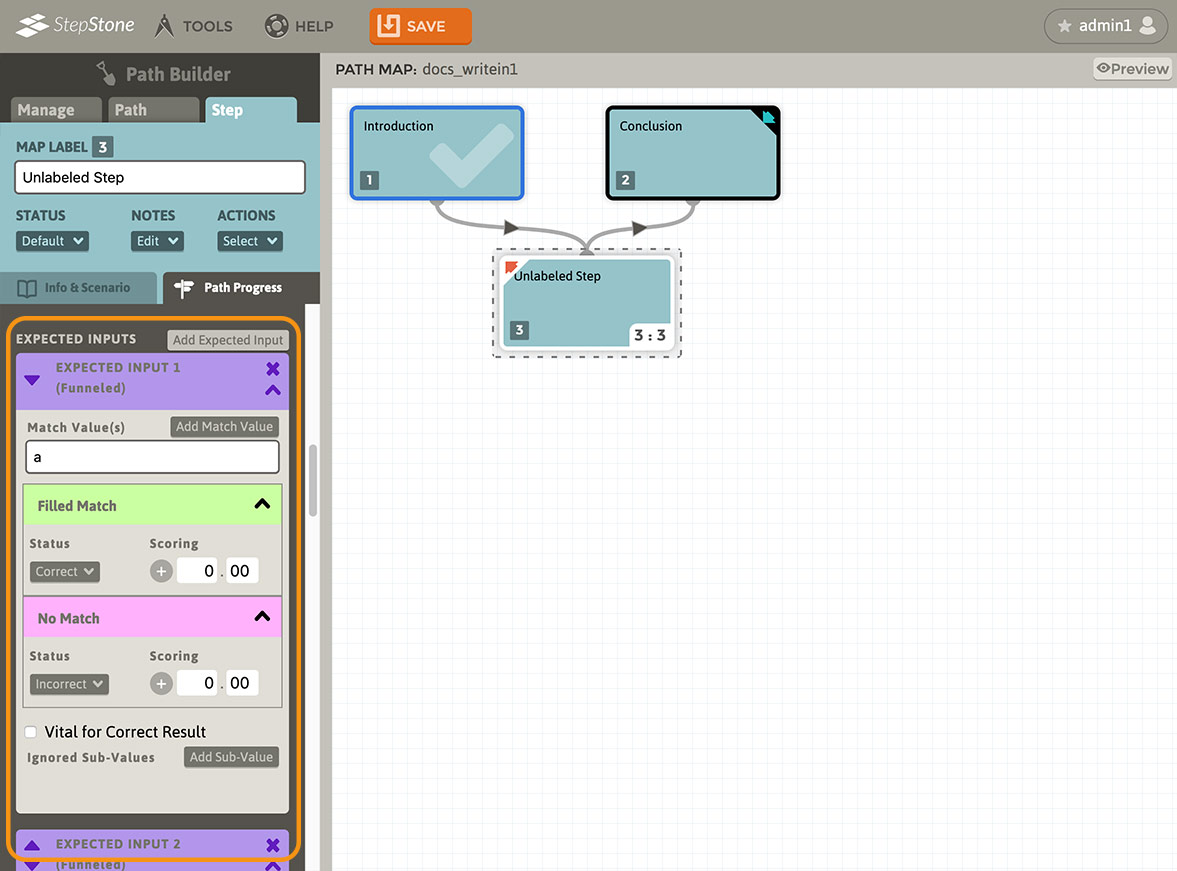
After swapping to this step assessment type, the step will immediately display a conflict notice, as there are not yet any Match Values set for evaluation.
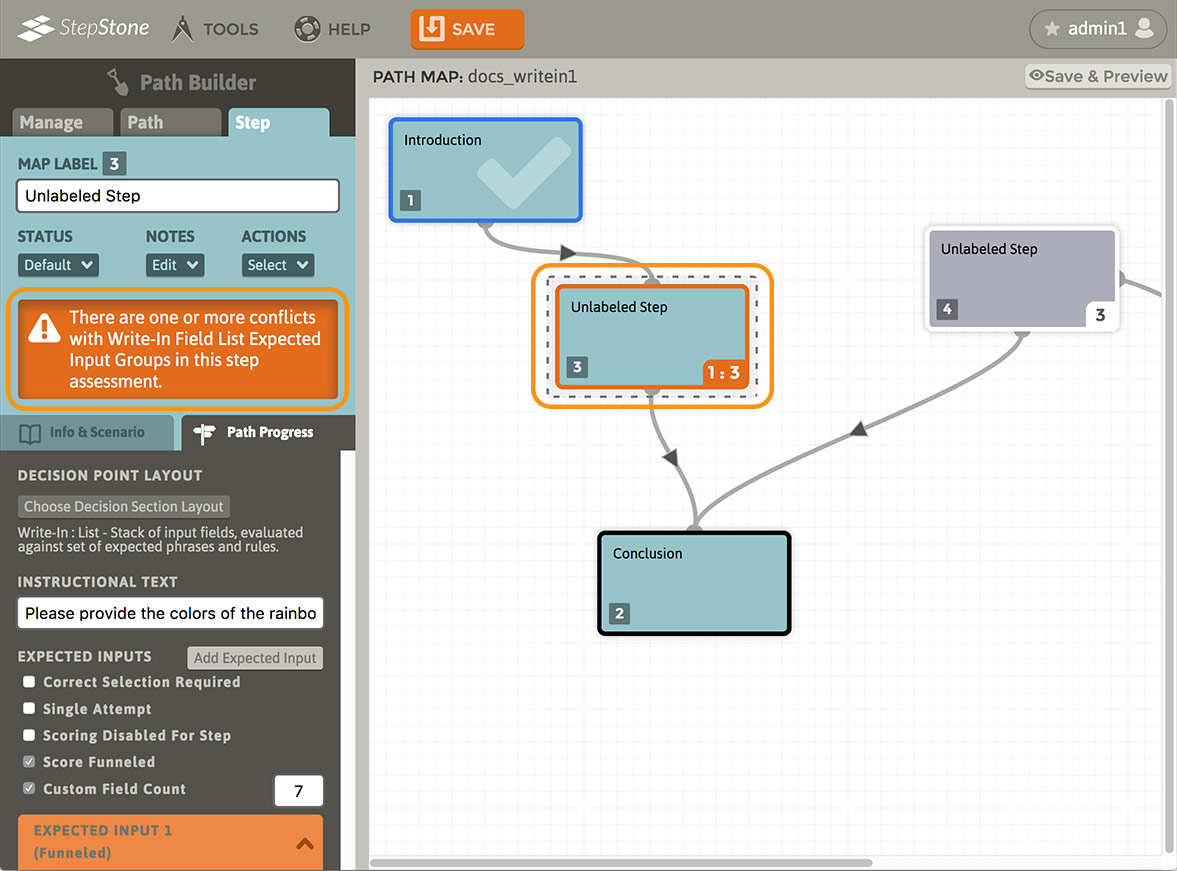
Adding Expected Input blocks – Use the “Add Expected Input” button to add a new Expected Input block to the top of the Expected Inputs stack.
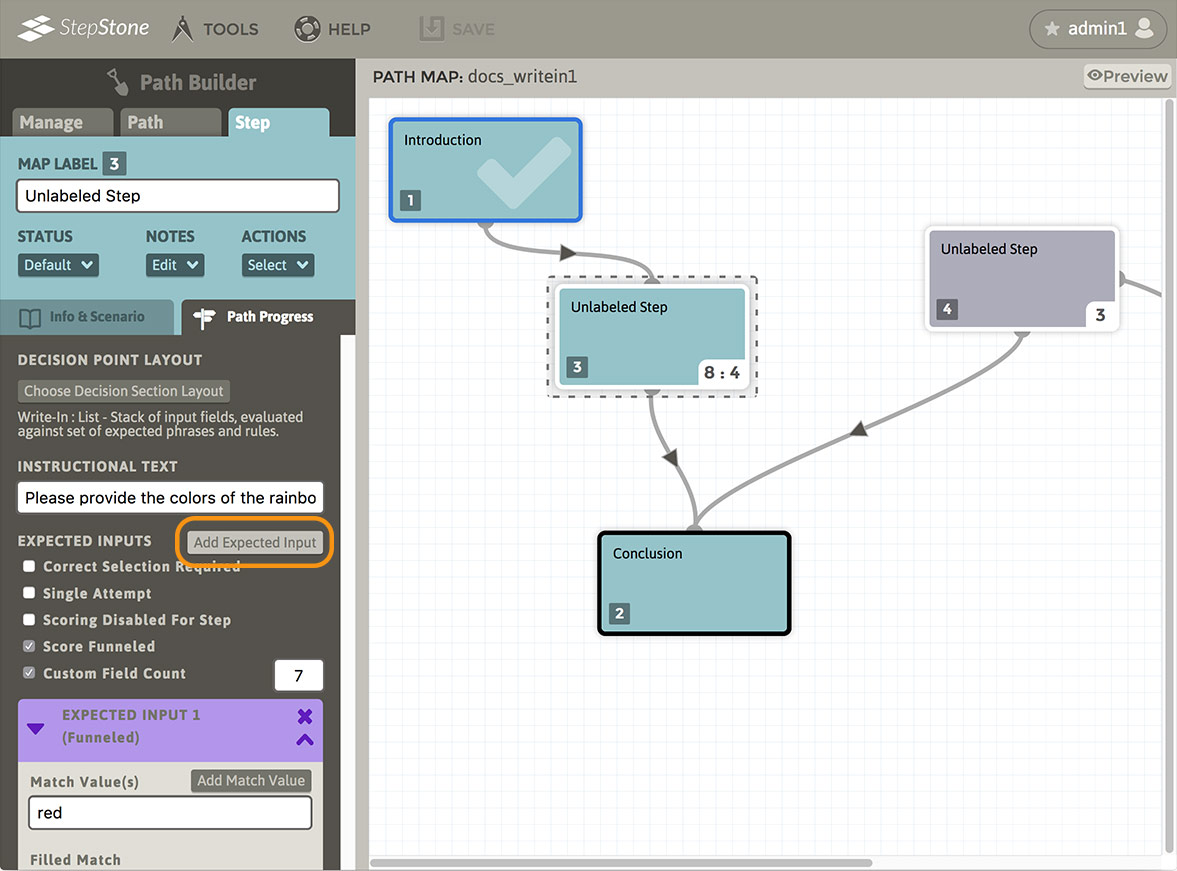
Each Expected Input block has the following features :
Match Values
- Stack of one or more input fields, the values are considered synonymous with each other (any value matched by the learner is accepted as a matching result for the expected input group).
- Must always be at least one input field in the value stack.
- Blank fields are highlighted red and are ignored by all result-determination processes. An Expected Input group can have one or more blank fields and still execute a match comparison, as long as there are at least one or more non-blank values present in the Match Value stack.
- Input field values across ALL Expected Input groups must be unique. If any identical values are entered, ALL of the Expected Input groups containing the clone values are displayed as conflicting and excluded from result-determination processes.
- Input field values can be simple, literal character strings, or can include the following additional determination filters :
- Asterisks (*) are single-character “wild cards” that allow any character to be accepted as part of a matching value. Values can include multiple asterisks, including “chains” of adjacent asterisks.
Example 1 :
“r*d” would accept “red”, “rod”, “r1d’, “r d’, but NOT “rd”, “reed”.
Example 2 :
“a*c**f” would accept “abcdef”, “a1c yf”, but NOT “abcde”. -
Tildes (~) are “range wildcards” that allow an arbitrary string of characters (or no characters at all) at the point in which they are placed in the expected input value. Values can include multiple tildes, but should not have any “chains” of adjacent tildes.
Example 1 :
“r~d” would accept “rd”, “red”, “reed”, “r3234nalwejoin2ish32d”, “r e r 3 2 e4rd”, “rrrrrrdddddd”, but NOT “wed” (because it is not “sandwiched” between an “r” and a “d”).
Example 2 :
“a~c~e” would accept “ace”, “a c e”, “a1111c2222e”, but not “ae”, “1c1e”, “acd”. - “Curly Braces/Brackets” ( { } ) are “focus groups” that enclose sub-strings and exclude characters outside of those focus groups from result determination. Can be multiple encapsulations in an input field value.
Example 1 :
“red {shoe}” would accept “red shoe”, “green shoe”, “10 shoes”, “shoe”, “shoes are great”, but NOT “red”, “red sho”.
Example 2 :
“{r}ed {shoe}” would accept “red shoe”, “r shoe”, “rshoe”, “only brown shoes”, but NOT “my shoe”, “red”. - The above filtering characters can be used in various combinations for many creative possibilities.
Example 1 :
“only {r~d} {sh*rts}” would accept “only red shirts”, “red shirts”, “redshorts”, “only red shorts”, “raaaaad shorts, man!”, but NOT “odd shorts”.
- Asterisks (*) are single-character “wild cards” that allow any character to be accepted as part of a matching value. Values can include multiple asterisks, including “chains” of adjacent asterisks.
- Adding Match Values to an Expected Input Group
- Use the “Add Match Value” button to draw a new input field to the bottom of the group’s value stack.
- New value input fields are blank and have the red indication as such.
- Removing Match Values
- Use the “X” button to the right of the field to be removed
- The Expected Input group stack, ruleset and the funneled handling is re-evaluated and re-processed.
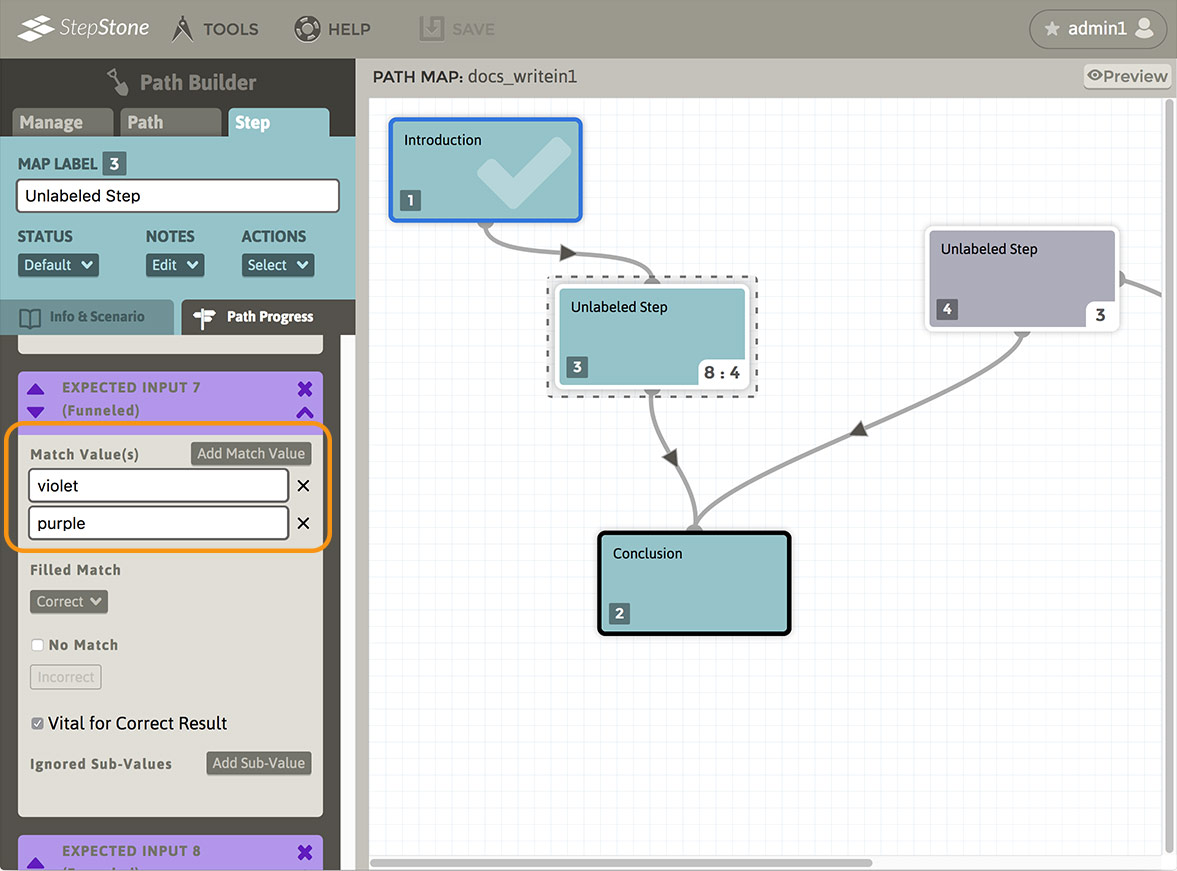
Filled Match
- Status result if any ONE of the Expected Input group’s input values is matched by the learner.
- Has corresponding Scoring block.
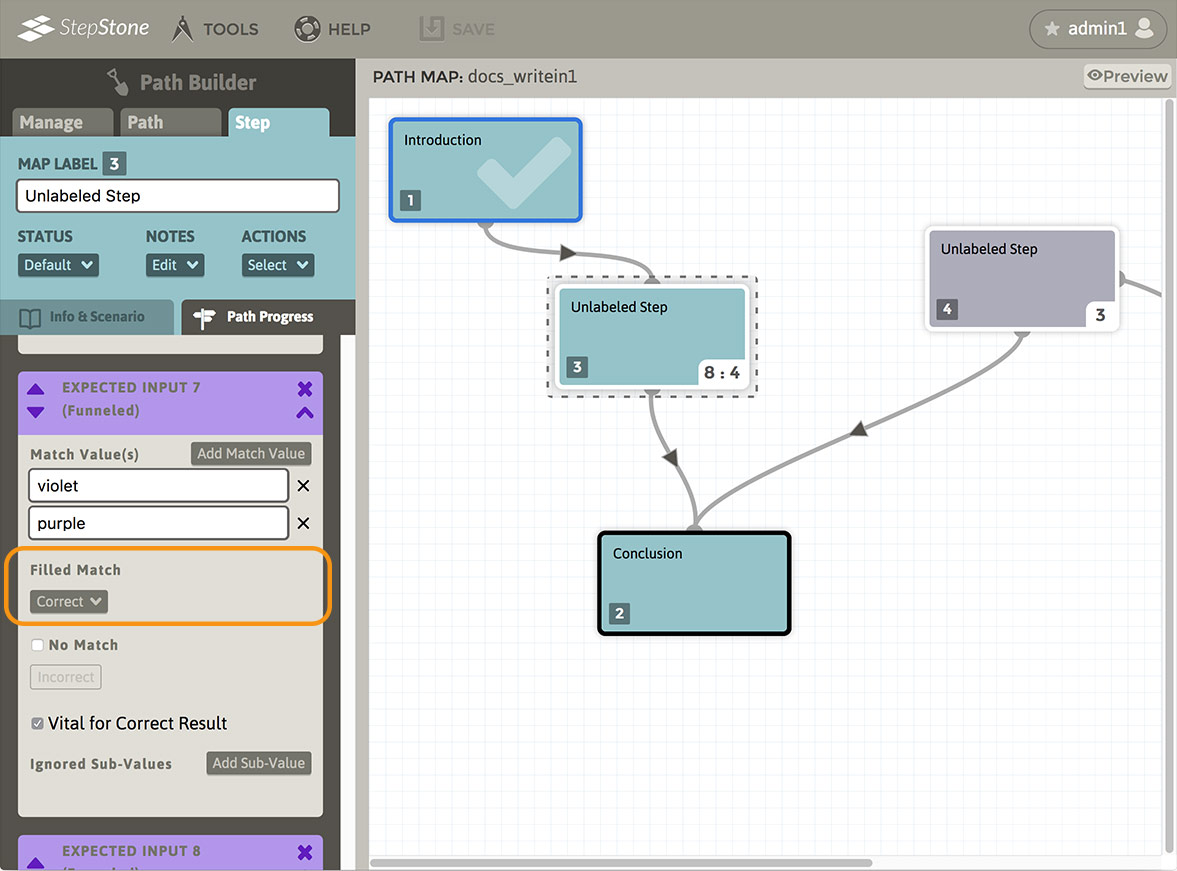
No Match
- Status result of NONE of the input values are matched by the learner.
- Has corresponding Scoring block.
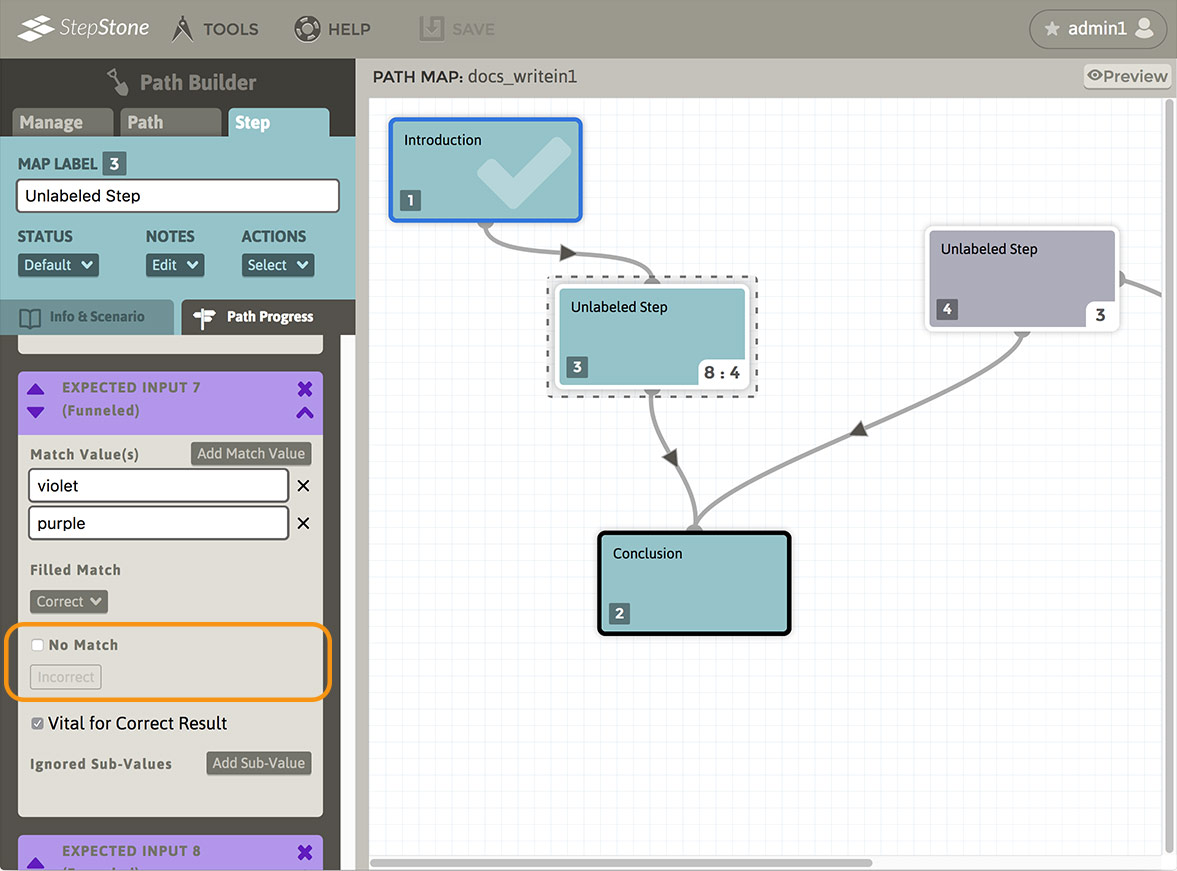
Vital for Correct Result
- Any Expected Input groups with an active Correct status will also have a toggle option available “Vital for Correct Result”.
- If NO Expected Input groups have this option toggled “on”, then ALL Correct responses MUST be matched by the learner to arrive at the Correct funneled result.
- If ONE OR MORE Expected Input groups have this option toggled “on” :
- ALL of the Expected Input groups with this option toggled “on” MUST be matched by the learner to arrive at the Correct funneled result.
- Any Correct responses that DO NOT have this option toggled “on” should be considered valid Correct matches, but are NOT vitally required to arrive at the Correct funneled result. Keeping these “non-vital” responses status as Correct allows for matches that may be “technically correct”. but should not affect the outcome as the Vital Correct matches (should not cause a “Partial” funneled outcome, for example.)
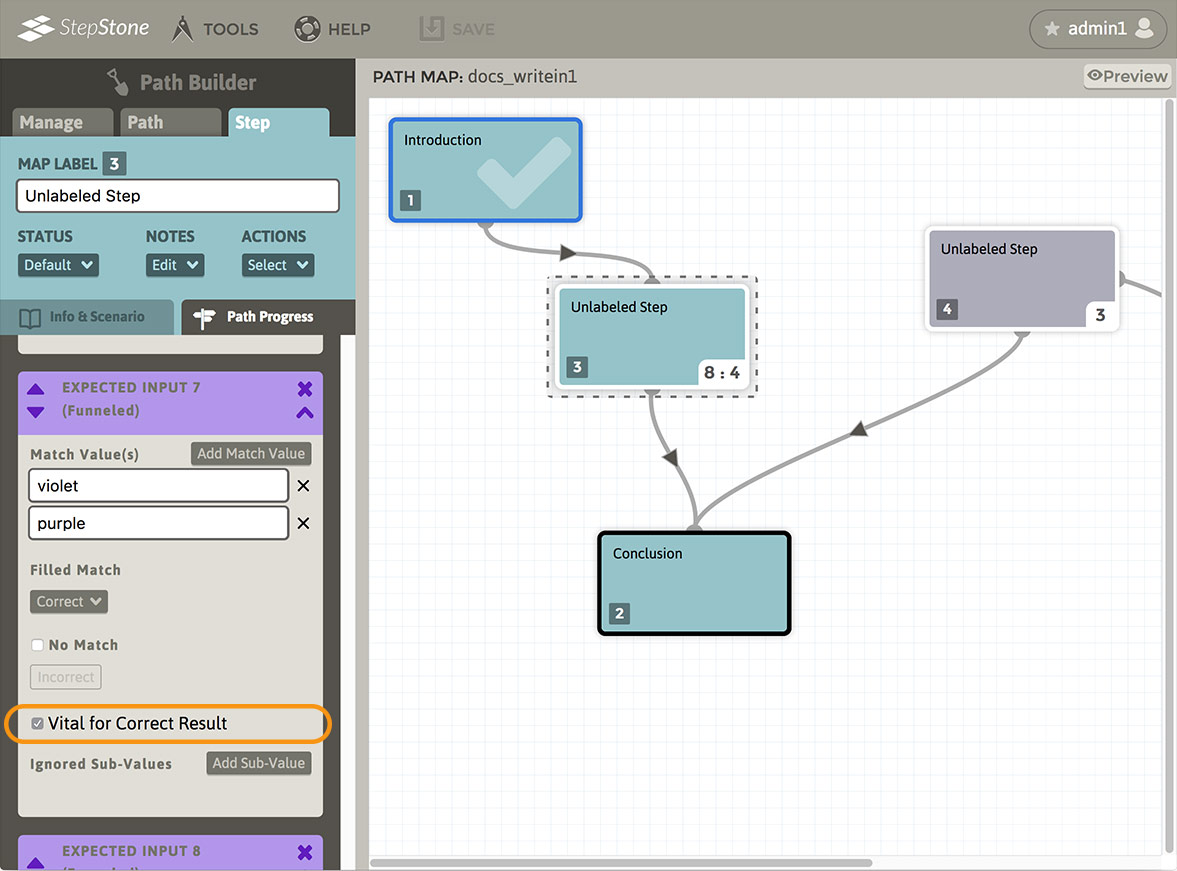
Ignored Sub-Values
Stack of input fields that can be applied independently to each Expected Input group :
- Each Ignored field allows the author to provide a string of one or more characters that will be excluded from the matching determination.
Example 1 :
Match values in a single Expected Input group are “green”, “blue”, “purple”. Ignored Values are “light-“, “dark-“. If learner enters “light-green” or “dark-purple”, either would be accepted as a Filled Match. - Use the "Add Sub-Value" button to add a new input field to the bottom of this field stack.
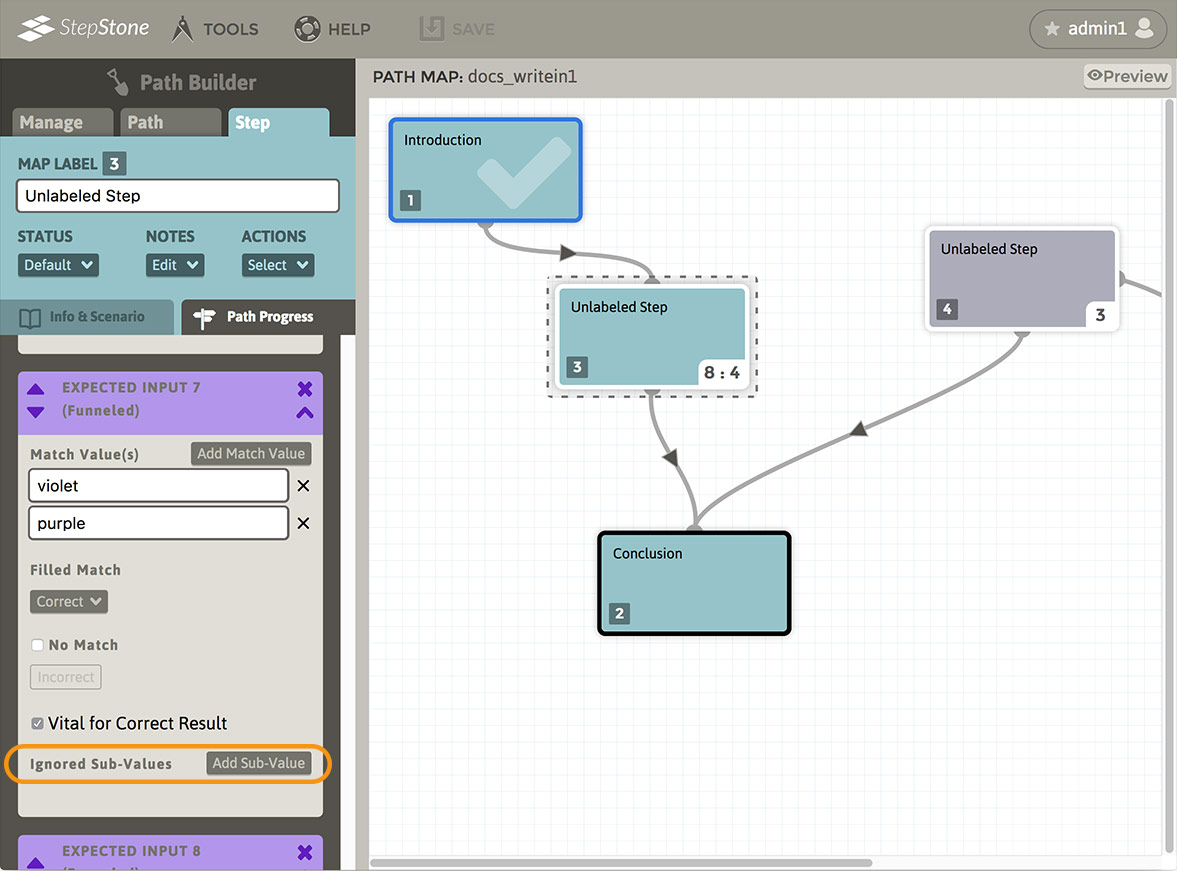
RULES
Minimum and Maximum Filled Requirement option toggles
- If Minimum Filled Requirement is toggled “off”, the minimum defaults to 1.
- If Minimum Filled Requirement is toggled “on” :
- The minimum value field is made available, defaults to 1, and must be between 1 and the number of available fields.
- A “Forced” option toggle is made available for this requirement. This blocks the learner from checking the step assessment results if the number of filled fields is lower than the min. value.
- If Maximum Filled Requirement is toggled “off”, the maximum defaults to the number of available fields.
- The maximum value field is made available, defaults to the number of available input fields, and must be between the Minimum Selected Requirement value (1, if Minimum Selected Requirement is toggled “off”) and the number of available input fields.
- A “Forced” option toggle is made available for this requirement. This blocks the learner from checking their assessment results if the number of filled fields is greater than the max. value.
- If the “Forced” option is not toggled “on” for a min/max rule, and the number of learner’s filled input fields is breaches that min/max value, then the funneled result will be forced to Nullify (see more about the Nullify funneled result below.)
- If toggled “on”, learner entries MUST exactly match the punctuation and spaces set by the author’s Match Values (no extra commas, dashes, etc. allowed).
- If toggled “off”, spaces and punctuation in the learner entries that are not specified in the author’s Match Values are ignored/allowed.
- If toggled “on”, learner entries MUST exactly match the capitalization of any characters as set by the author’s Match Values.
- If toggled “off”, capitalization is NOT part of the matching determination.

GLOBAL IGNORE LIST
- Behaves like the Ignored Sub-Values entries in each Expected Input group, but applies globally to ALL learner inputs / matched value determinations.
- Use the "Add Ignored Item" button to add a blank input field to bottom of this field stack.
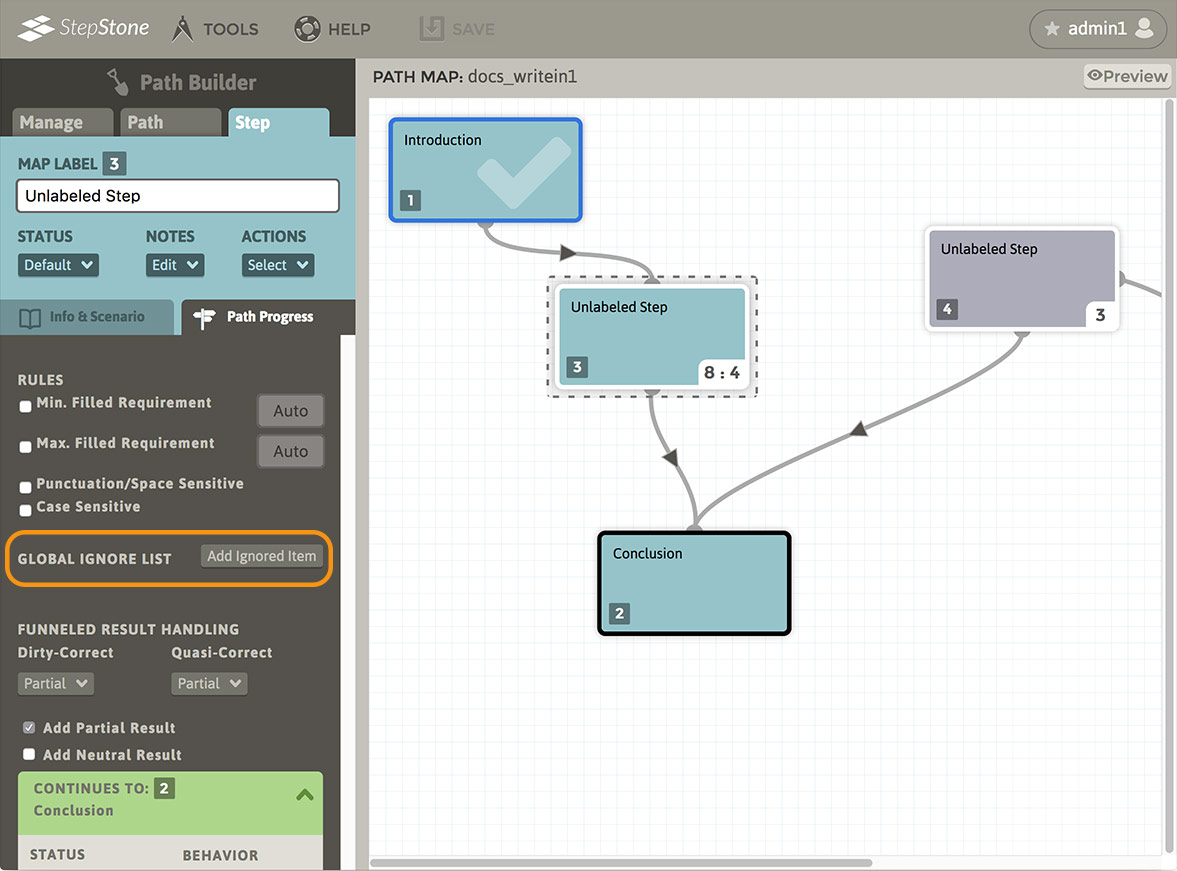
WRITE-IN FIELD LIST CONTROLS
- Capture Response Only
Authors may optionally set the Write-In assessment type to only capture the learner’s responses, and not perform any result determination or match-checking of the input values. This is designed to be used along with the external progress tracking system (for non-automated, human review of the learner responses), but is available as an option even without external tracking being utilized. Toggling this option "on" :- hides the other assessment toggle controls.
- hides all parameters within all expected input groups (only the expected input group boxes themselves remain to indicate the amount of input fields that the learner will encounter).
- sets a single "pass through" funneled result output for setting the destination Step, with an optional feedback response.
- places a "CRO" (Capture Response Only) indicator in the Step box on the Step Map.
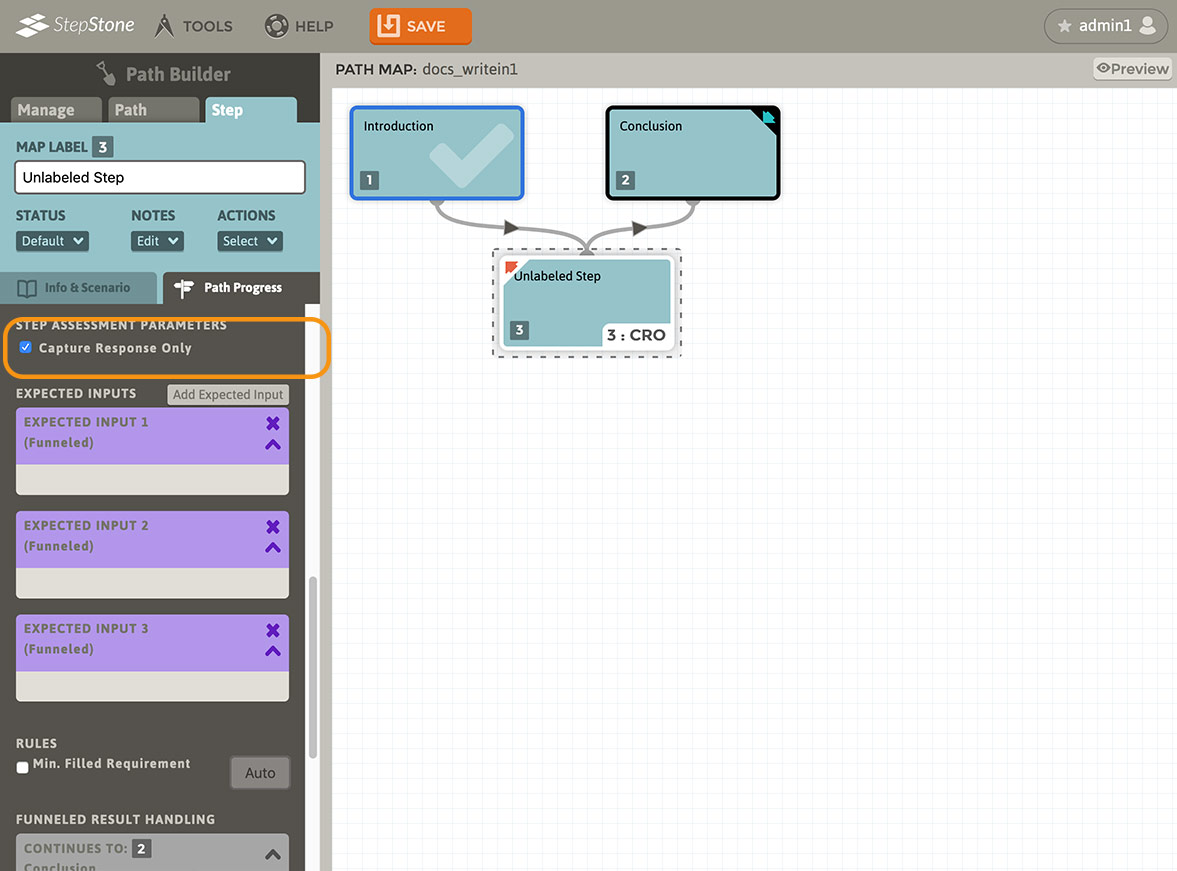
- Custom Field Count toggle option
- If toggled “on”, the number of input fields presented to the learner is assignable by the Author (must be a value from 1-99).
- If toggled “off”, the number of input fields matches the number of Expected Input boxes.
- Fewer fields than the number of Expected Input groups is possible, but requires disciplined planning to author, especially if utilizing scoring. More fields than the number of Expected Input groups can be used to create intentional “dead fields” that should remain blank in order for the learner to achieve optimal results. Can be used alongside the min. / max. required filled field controls.
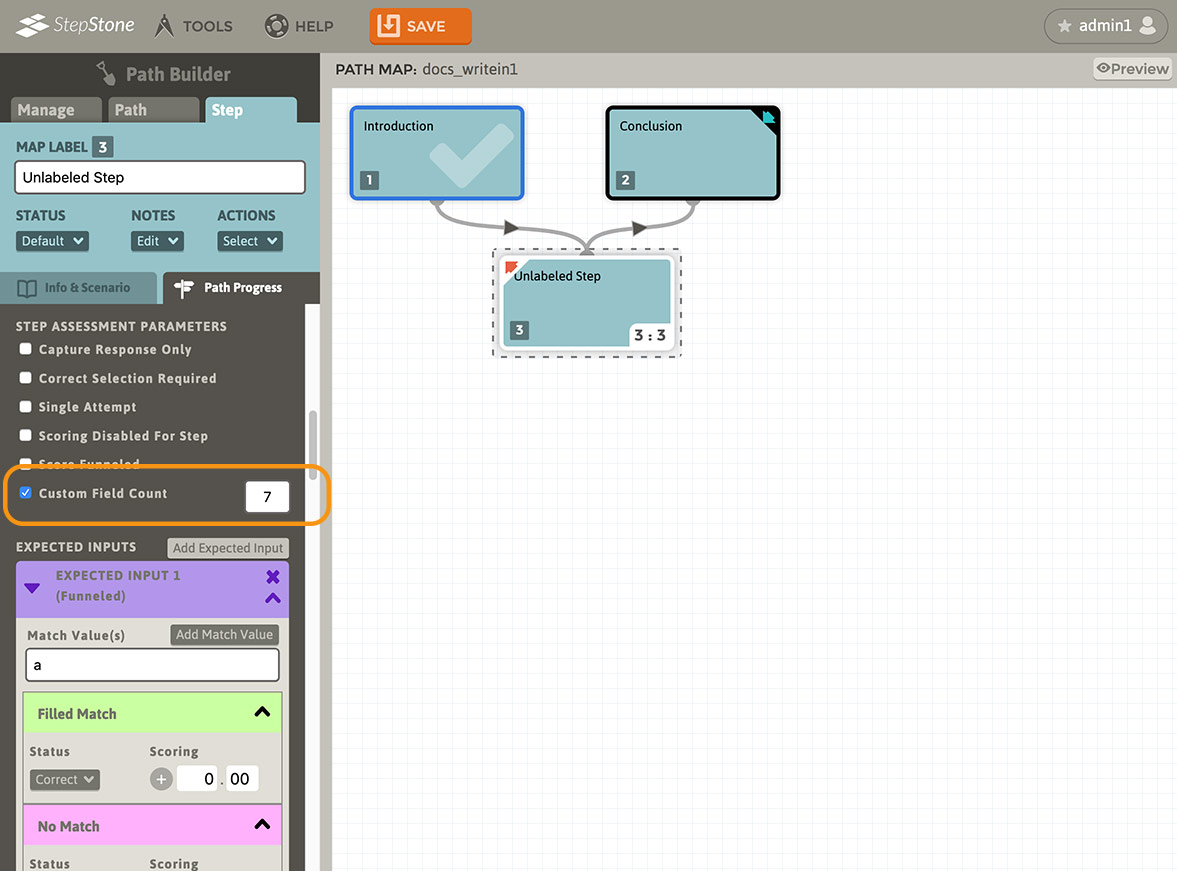
FUNNELED RESULT HANDLING
Scroll down the editor panel to see how the assessment's responses are funneled to different results. Under Funneled Result Handling, you may see one or more drop-down options for handling certain response conditions :
- Dirty-Correct: Learner provides one or more Correct AND one or more Non-Correct responses (only available if both Correct and Non-Correct responses are possible.)
- Quasi-Correct: Learner provides one or more, but not all, necessary Correct responses AND no Non-Correct responses (only available if two or more Correct responses are possible.)
| Response Combination | Funneled Result |
|---|---|
| Correct (no Non-Corrects, all necessary Corrects) | Correct |
| Correct (no Non-Corrects, but not all necessary Corrects) | Quasi-Correct |
| Partial (only) | Partial |
| Incorrect (only) | Incorrect |
| Neutral (only) | Neutral |
| Correct + Incorrect | Dirty-Correct |
| Correct + Partial | Dirty-Correct |
| Correct + Neutral | Dirty-Correct |
| Correct + Incorrect + Partial | Dirty-Correct |
| Correct + Incorrect + Neutral | Dirty-Correct |
| Correct + Partial + Neutral | Dirty-Correct |
| Correct + Incorrect + Partial + Neutral | Dirty-Correct |
| Incorrect + Partial | Partial |
| Incorrect + Neutral | Incorrect |
| Incorrect + Partial + Neutral | Partial |
| Partial + Neutral | Partial |
| Nullify (if applicable, regardless of combination with any other status type) | Nullify |
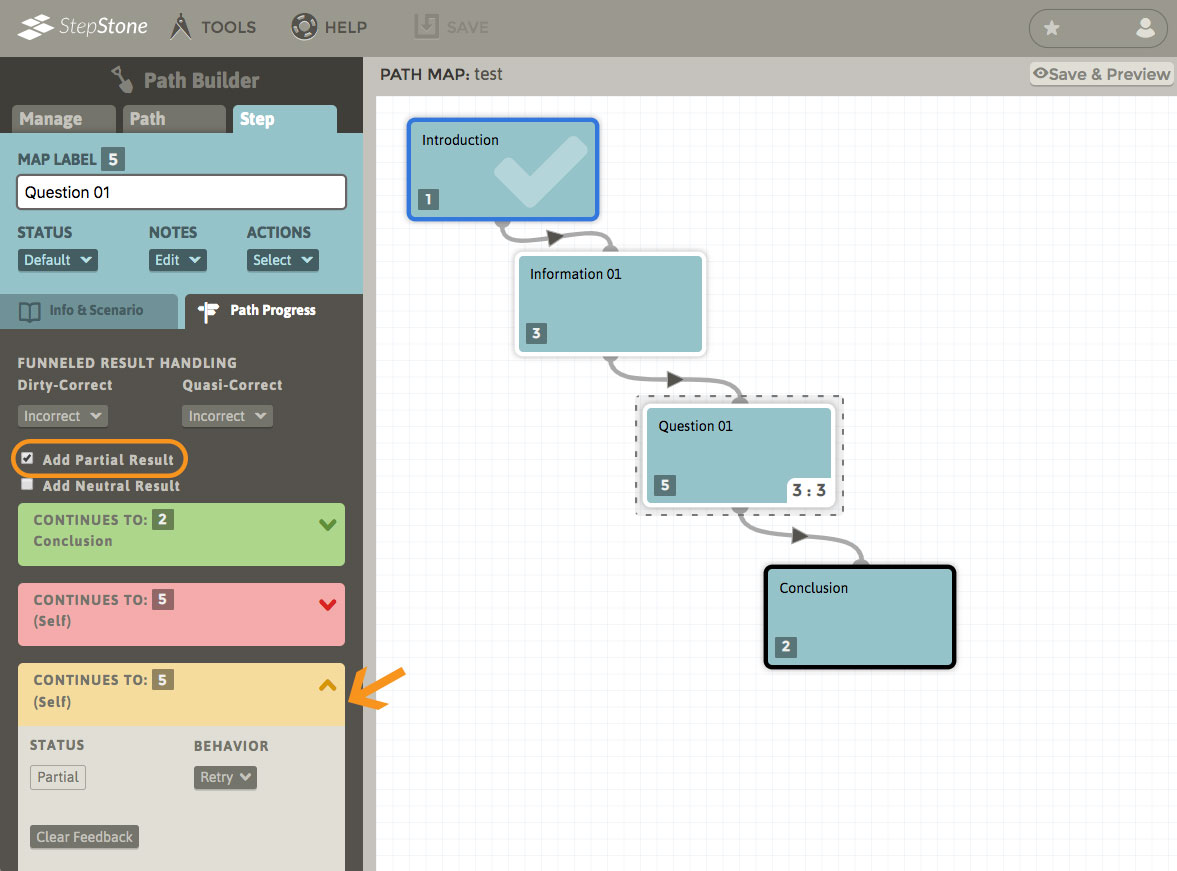
For each funneled result, add the text you wish the students to see by typing in the Feedback Text box. If the feedback text is left blank, the student will still see a popup with the resulting status (Correct, Incorrect, etc.) If you do not wish to have any feedback popup for a given funneled result, use the “Clear Feedback” button — with no feedback applied to the funneled result, the learner will simply move forward to the funneled result's target step. Test your changes and settings by viewing the step’s Preview.
It is possible that one or more existing funneled results may not be reachable by the learner due to assessment structure or the available response combinations, etc.. This is normal and should not be an issue.
Scoring Write-In Field List Assessments
If scoring is enabled, an option toggle "Score Funneled" is available in the EXPECTED INPUTS options.
- If toggled "off" :
- Scoring fields are placed in all non-Neutral, non-Nullify Expected Input match results. A toggle box is provided with each scoring field.
- Scoring is tallied from the learner's input match results. All score-bearing, toggled "on" Expected Input match results are summed.
- If toggled "on" :
- All scoring fields are removed from the stack of Expected Inputs, and instead scoring fields are placed in all non-Neutral-status, non-Retry-behavior funneled handler result boxes.
- No score tally is performed for the assessment, all scoring is set by the funneled results.
Here we are presenting the learner with a stack of 7 input fields. The learner's task is to provide the colors of the rainbow (in any order.)

There are actually 8 Expected Input boxes set up in the authoring tool. The 8th box is configured to force a Nullify result if the learner enters the word "black" as a color. The Custom Field Count option is toggled "on", and has a value of 7. This results in the learner only seeing 7 input fields (if toggled "off", the learner would see 8 input fields.)
The other 7 Expected Input boxes are configured thusly:
- The words red, orange, yellow, green, blue, indigo, and violet (or) purple are the matching values. Either purple or violet will suffice as the match for that Expected Input box.
- Red, orange, yellow, green, blue, and violet (or) purple have "Vital for Correct Result" toggled "on". Indigo is not as commonly recalled as a main color in the rainbow spectrum, so it is not set as Vital. If the learner does not enter indigo as one of the values (leaves a blank field), there is not a penalty for the omission (if all other colors are matched, funnels to Correct with or without indigo.)
- Only "Filled Match" results are collected. The "No Match" results for all Expected Input boxes are toggled "off".
Any expected values that are not entered by the learner, or unexpected learner values (in this case, any other colors) are tallied as Incorrect results toward the funneled outcome.
